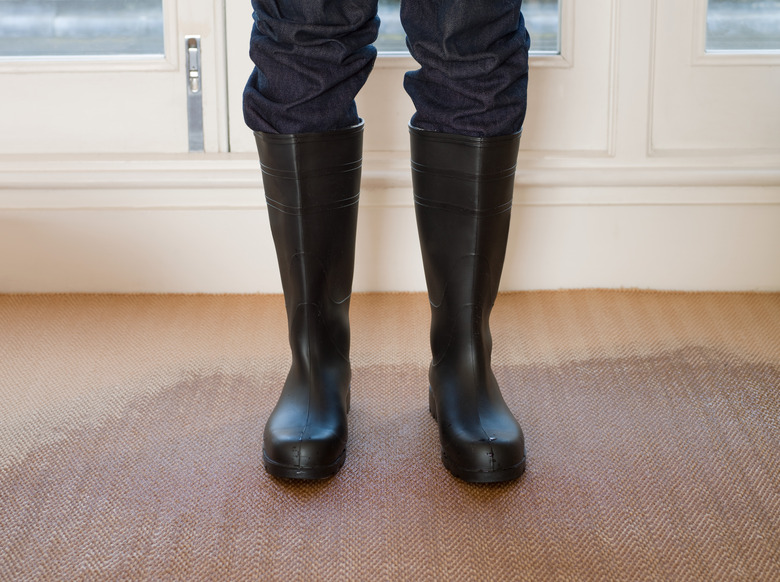How To Dry Carpet After Water Damage
Water damage wreaks havoc on carpets, and drying them can prove to be a massive undertaking. Wall-to-wall carpet isn't cheap, however, so trying to salvage wet carpet when you can makes financial sense. You'll need to be patient with the process, however. It can easily take 24 hours to dry the carpet under the best of circumstances. It can take several days when conditions are not ideal.
Can You Save It?
Can You Save It?
When dealing with wet carpet, the first step is to make sure that what you have is salvageable. If your carpet is old and worn out, it may not survive all the cleaning that's about to happen. If the water on your carpet contained sewage, it's best to dispose of the carpet and replace it. Unfortunately, especially during natural disasters, you may not have a chance to get to your carpet right away. If it's been wet for a few days and it's already starting to mold, throw it away rather than trying to save it.
Things Needed
-
Carpet padding (optional)
How To Dry Carpet After Water Damage
1. Get Rid of the Water
Before you can start drying your carpet in earnest, you need to sop up as much water as you possibly can. Think of drying your carpet as doing laundry. After your washing machine runs a spin cycle to remove most of the water, you can throw your clothes in the dryer and finish the drying process. If you put the laundry into the dryer before the washer's spin cycle, you'll have a wet, soppy mess of clothes that will take forever to dry. The same is true of your carpet.
-
Empty the room. You'll never get all the water if there is heavy furniture sitting on parts of the carpet.
-
Use a shop vac to suck up as much of the water as you can.
-
Lay towels on the carpet and push them into it to soak up any remaining water. Walk across the towels so you know they've been adequately pushed into the carpet. Swap out the towels for fresh ones when they become soaked through.
-
Lift the corner of the carpet and peek at the padding and subfloor. If the subfloor and padding are saturated, you need to pull back the carpet so they can dry too.
2. Circulate the Air
Drying carpet requires massive amounts of airflow, which you'll need to supplement. It's not enough to simply open a few windows and turn on a fan. These steps are important, of course, but you need to go much further.
- Open all the windows in the room. If you can, open an exterior door as well.
- Bring every fan you own into the room and set them up at various places around the space. Turn on your air conditioning and the ceiling fan as well if applicable.
- Run a dehumidifier in the room.
- Prop up the edges of the carpet if you can and place a fan there, directing the air from the fan under the carpet to dry the subfloor and the padding. This will also help get air under the carpet. You may wish to consider renting an industrial air blower.
- Leave the fans running for a few hours. Then, come back and reposition your fans or prop up a different area of the carpet.
3. Recheck the Subfloor
If your carpet is drying out well but the padding and subfloor refuse to cooperate, you need to roll up the carpet and temporarily remove it. This lets the subfloor dry properly and gives you access to it so you can easily disinfect it.
- Roll up the carpet and remove it. If it's too large to realistically do so, fold it in half and work half the room at a time.
- Reposition your fans so they are blowing across the exposed carpet padding and floor. Leave the fans to run for a few hours.
- Check to see if the padding and floor are dry. If your padding failed to recover well, replace it. Otherwise, fold it back to reveal the subfloor.
- Disinfect the completely dry subfloor. Mix 1 cup of bleach and 1 gallon of water in a spray bottle. Spray the subfloor with the mixture and let it air dry. This will help kill any mold and bacteria before you cover the floor again.
4. Reinstall and Clean the Carpet
When the padding is dry or has been replaced, it's time to put the carpet back in the room. It's imperative that you wait until everything is completely dry before you do so. Rushing the drying process invites problems.
- Place the carpet back into position in the room or unfold it so it covers the floor again.
- Shampoo or steam clean your carpet. This will remove any stains and help ensure that no bacteria is still lurking in the carpet.
- After cleaning, move the furniture back into the room.
